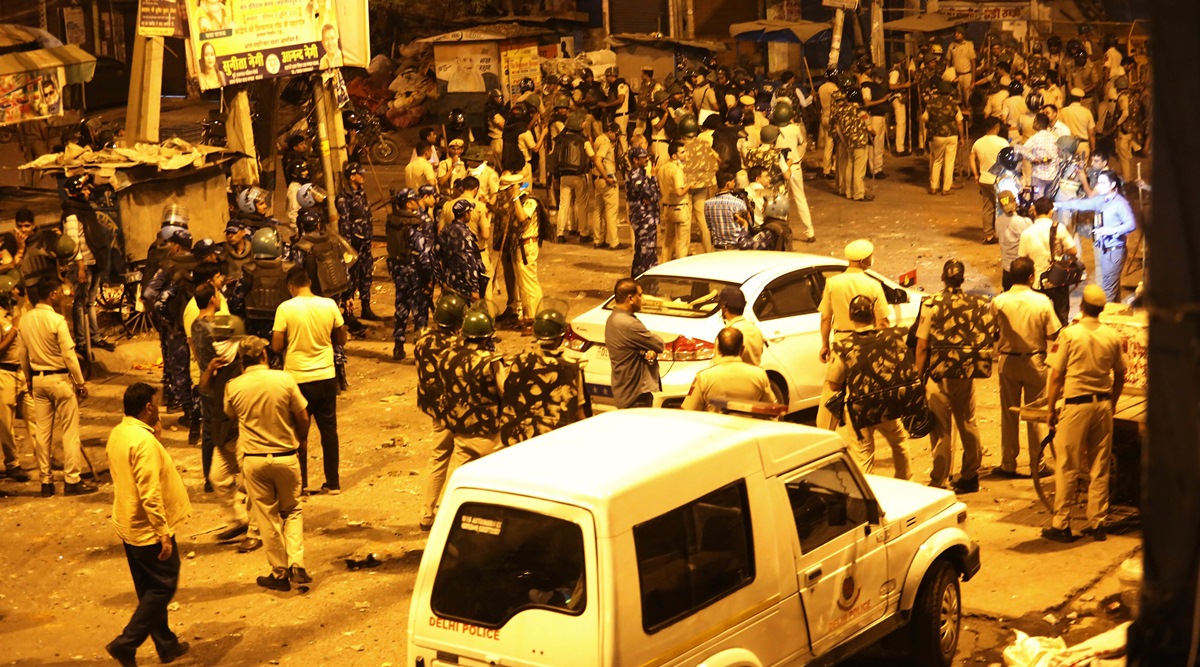 Thirty-seven people were chargesheeted for the riots in Jahangirpuri in April this year. Express file
Thirty-seven people were chargesheeted for the riots in Jahangirpuri in April this year. Express fileIN A first, the Delhi Police used the Facial Recognition System (FRS) to arrest and “confirm” the presence of several accused at the site of the Jahangirpuri riots that took place four months ago — and the images will be presented as evidence in court. Of the 37 chargesheeted, over 25 accused have been produced so far at the Forensic Science Lab (FSL) in Rohini to match CCTV visuals using FRS, The Indian Express has learnt.
However, unlike the usual FRS procedure, where visuals are matched with dossiers, official IDs or still images of faces, the police have “tried to achieve maximum accuracy” this time by clicking photos of the accused in the same pose and angle as they were captured in CCTV footage, sources said.
During the Northeast Delhi riots in 2020, the police had used FRS to make arrests but were later pulled up by the Central Information Commission for not furnishing details about the technology’s accuracy and how it was used. Police sources said not many details were shared at the time since the system was “only used” to make “a few arrests” and not as “evidence” in the courts.
This time, sources said, the Crime Branch used FRS with permission from the local court. The Jahangirpuri clashes broke out on the occasion of Hanuman Jayanti in April, leading to injuries to 8-9 persons including police personnel.
Subscriber Only Stories
While initial arrests in the case were made by the police in Northwest district, the Crime Branch used FRS to make further arrests. DCP Vichitra Veer (Crime Branch) said, “With the permission of the court, the accused persons were photographed through FSL to match against the available video footage.”
Explaining the procedure, a senior police officer said, “The footage recovered from the lanes of Jahangirpuri were of good quality and helped us in identifying people. To confirm their presence, we took permission from the court and took the accused to the FSL in Rohini. Their footage was pulled up and they were asked to pose in the same manner as they were found in the footage. This helped us in making successful arrests.”
Sources said that since the procedure requires technical and manual analysis, it takes time to produce results. Also, the officers have to get a “clear still” from CCTVs for the system to work, they said.
Senior officers told The Indian Express that the entire exercise was conducted in 7-8 days, with groups taken from the Tihar jail to the FSL every day.
“CCTV footage might have limited evidence value in the courts. The accused can always deny their presence in the visuals. To prevent this situation, we needed photos in the same angle and the same pose. This also helped us in identifying those who were carrying weapons and instigating crowds,” said an officer.
Analysis of CCTV footage and mobile videos also revealed the activities of individuals in the crowd, officers said. “Persons carrying rods, bricks and stones were seen, and their images were taken from CCTV. This was further processed in identifying rioters,” the officer said.
“We saw 4-5 accused wave their hands to call other people or make gestures to invite crowds for rioting. Some are seen picking up bags filled with glass bottles and giving them to others. These visuals have also been recovered and saved,” said the officer.
Police investigations have also revealed that “2-3 persons from the VHP rally on Hanuman Jayanti”, which triggered the riots, carried weapons.
Among the 37 chargesheeted, the police claim that three accused, identified as Mohammed Ansar (35) and his associates Tabrez Khan (36) and Ishrafil, are allegedly the “key conspirators”. “They have been spotted in CCTV footage. Ansar and Tabrez have been arrested while Ishrafil is still on the run. Police recovered bricks and glass bottles from Ishrafil’s residence,” the officer said.
- The Indian Express website has been rated GREEN for its credibility and trustworthiness by Newsguard, a global service that rates news sources for their journalistic standards.

